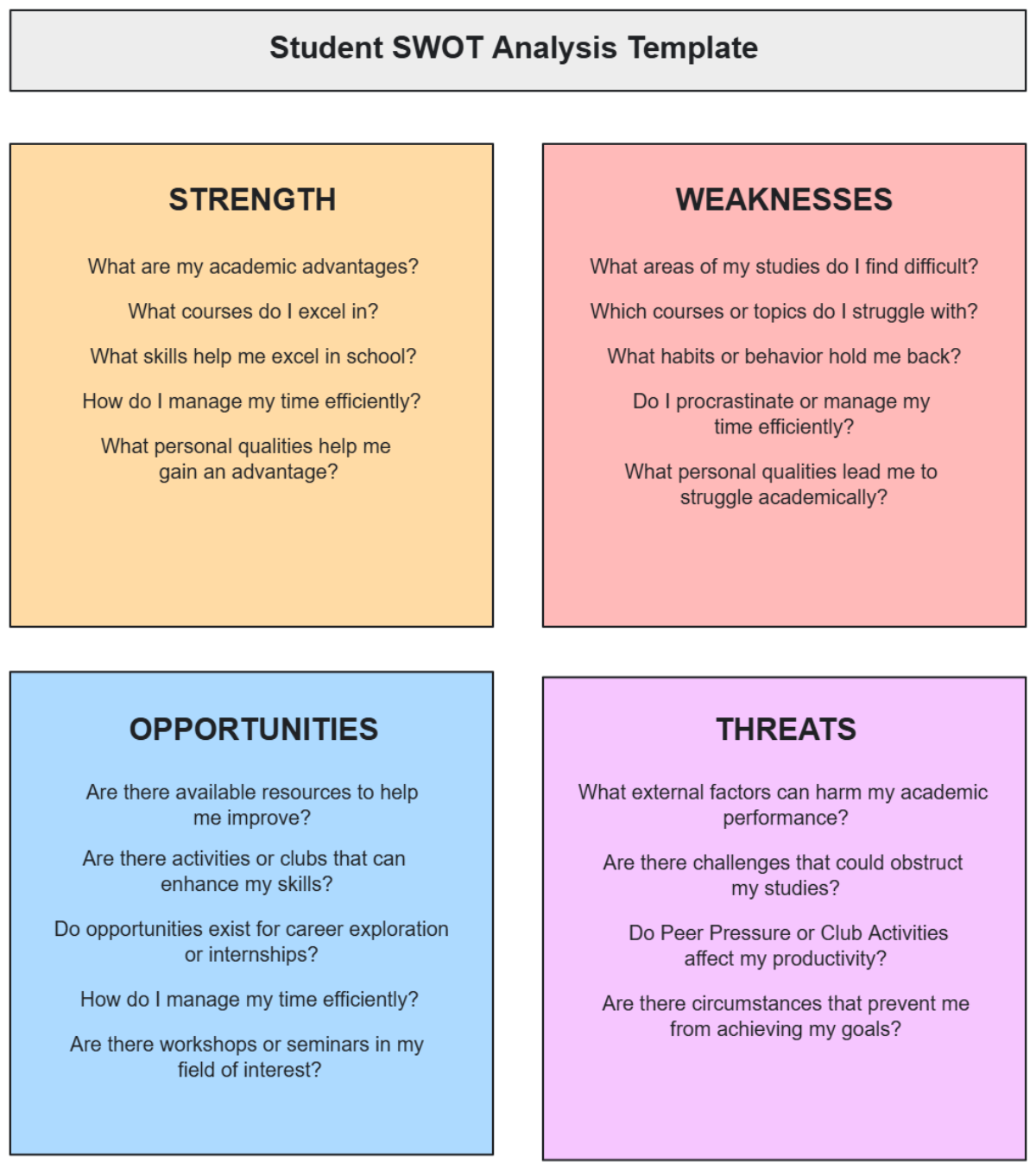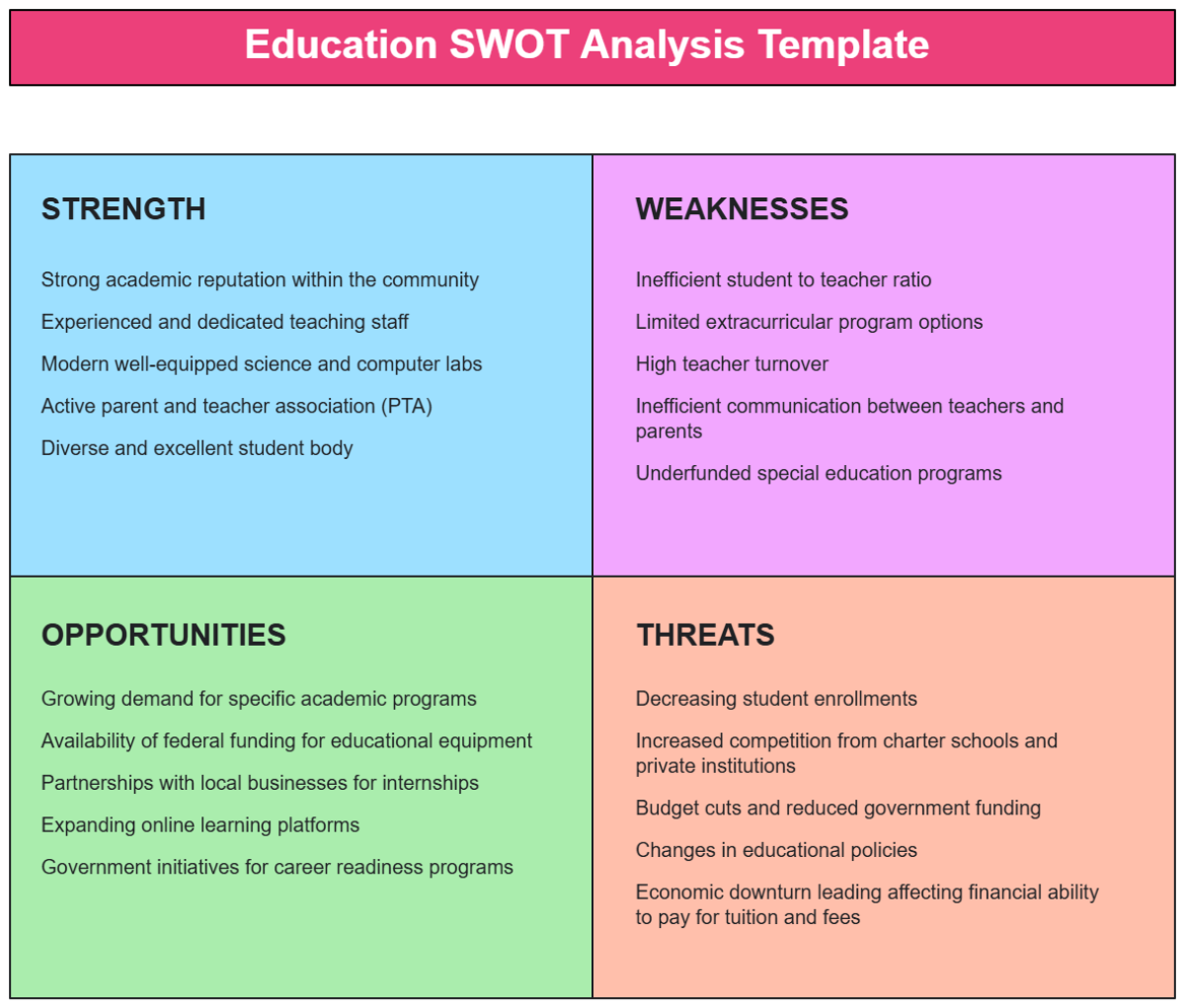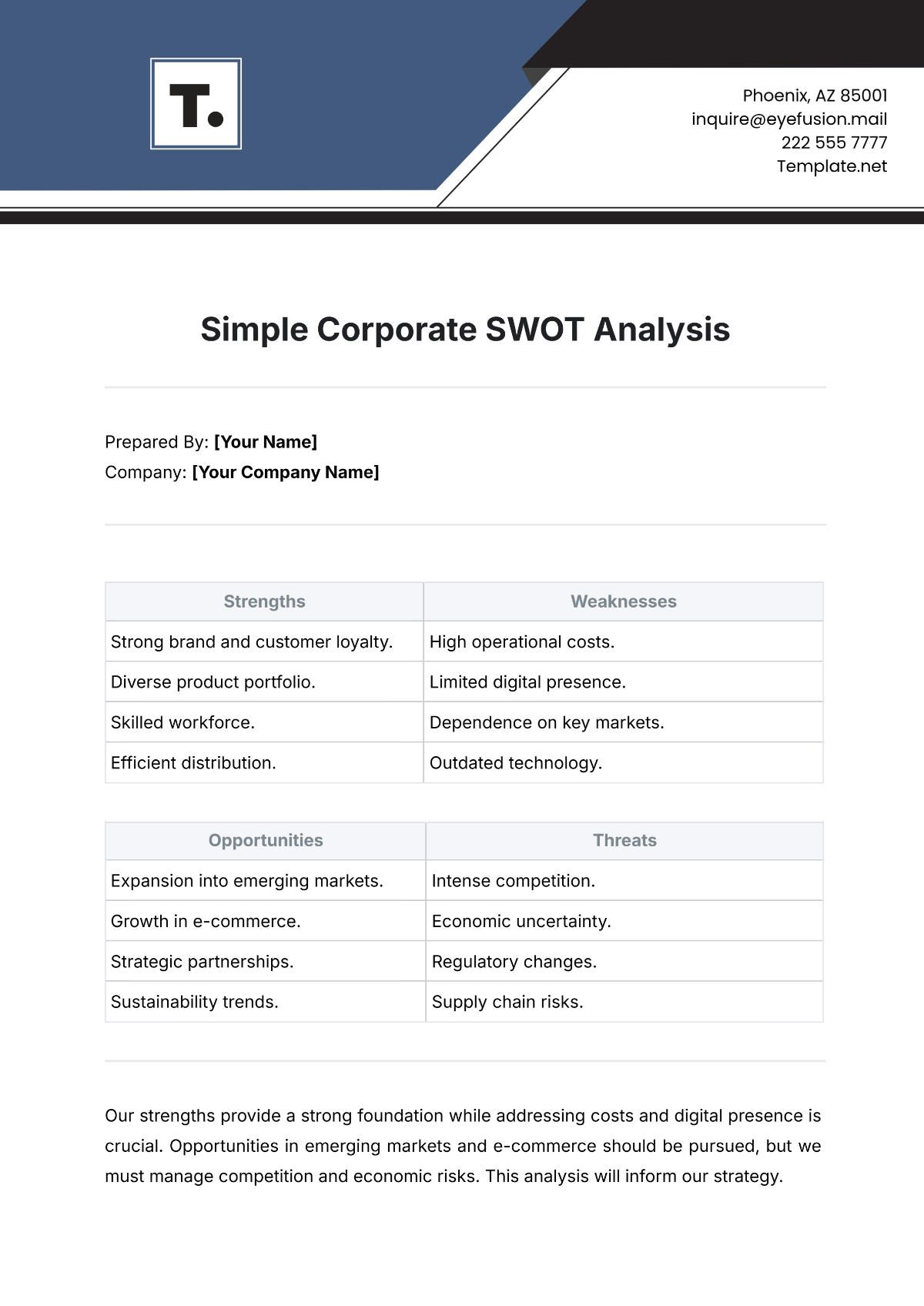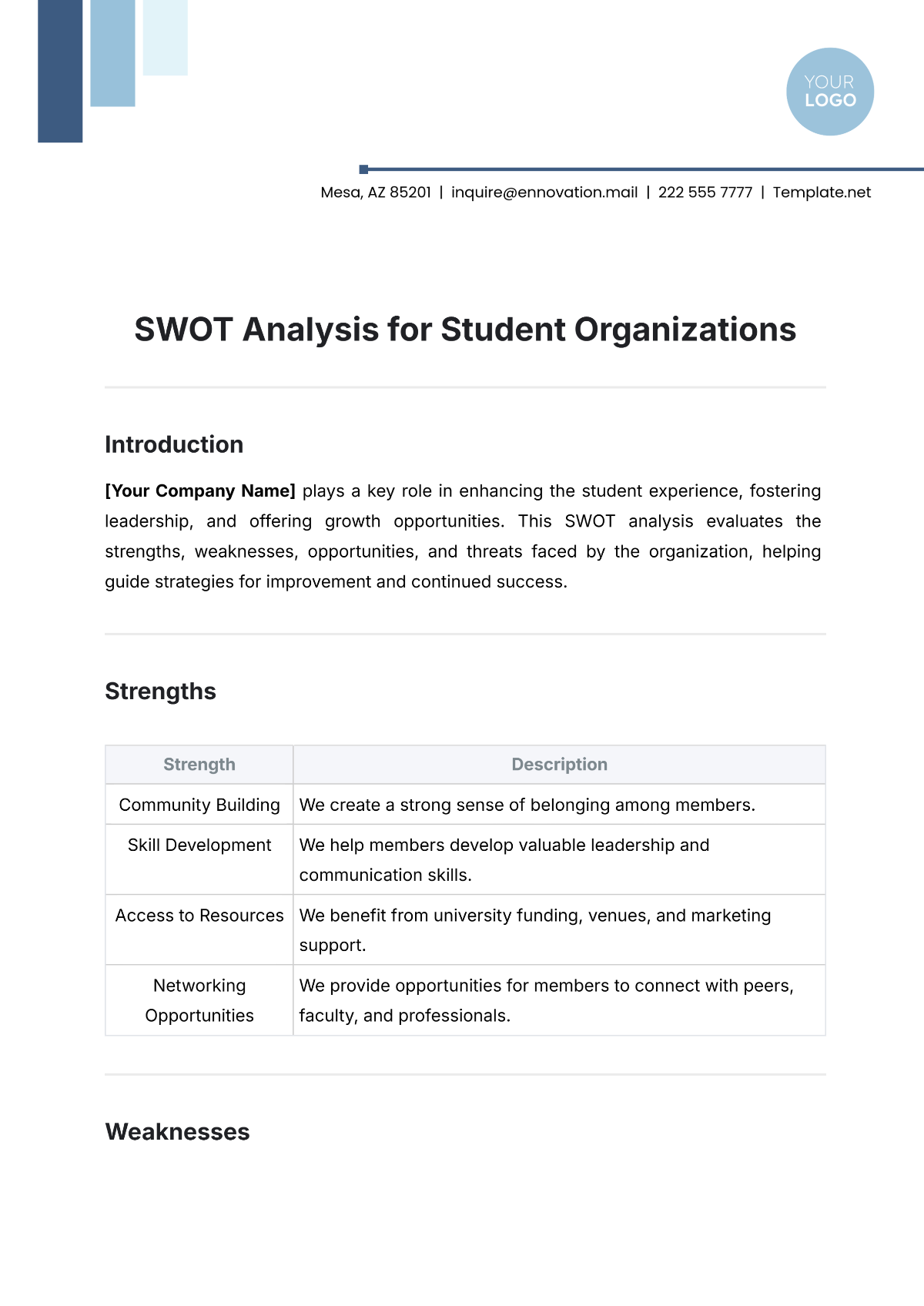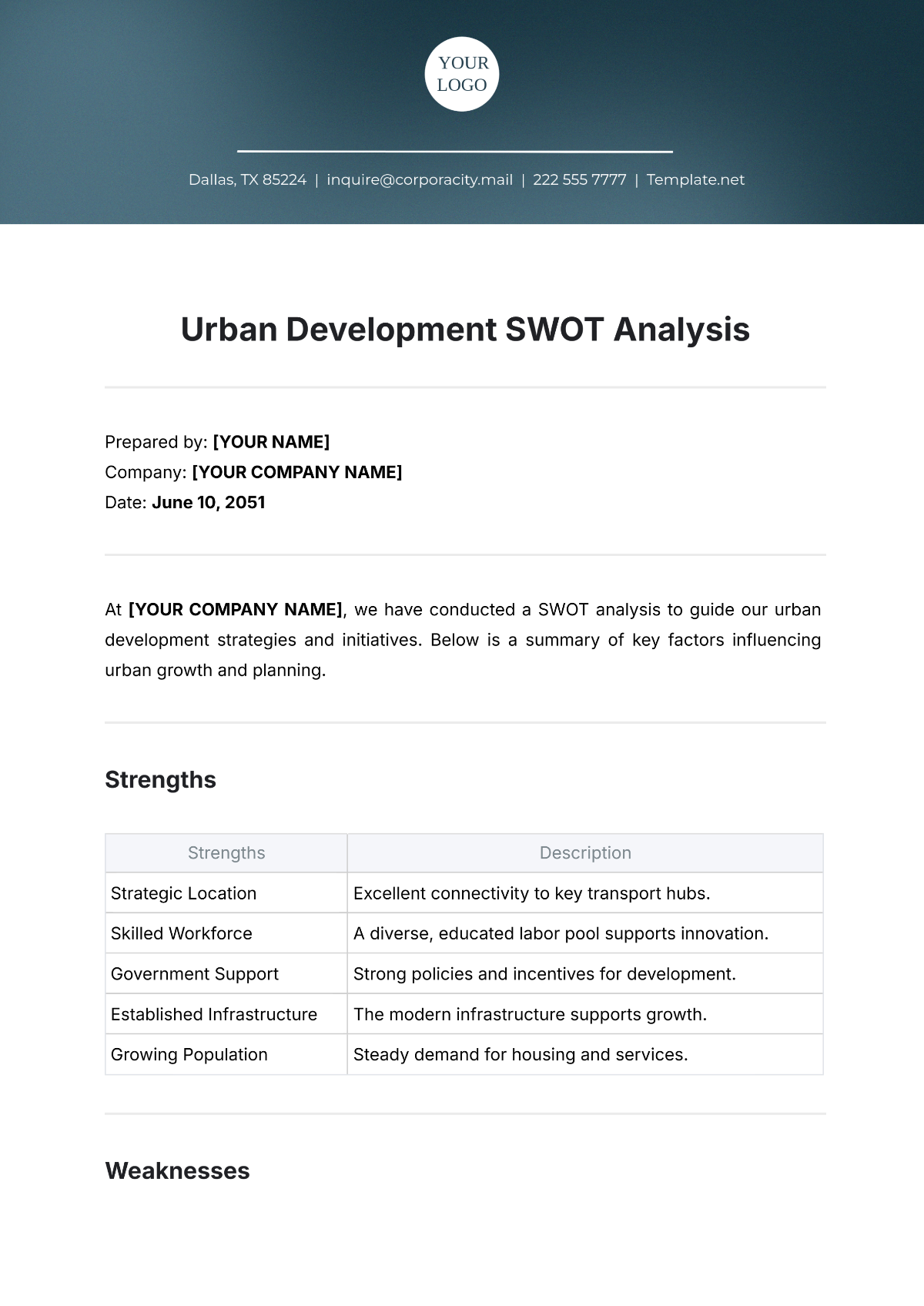B2B SWOT Analysis
This comprehensive SWOT analysis delves into the internal and external factors affecting [Your Company Name] in its B2B operations. It is designed to offer actionable insights that can guide strategic decision-making, foster growth, and enhance overall business performance from 2050 and beyond. Understanding the company's strengths, weaknesses, opportunities, and threats is crucial for making informed choices in an increasingly competitive and dynamic business landscape.
I. Strengths
A. Robust Product and Service Portfolio
Innovative Offerings
[Your Company Name] has consistently been at the forefront of innovation, offering products and services that cater to the evolving needs of B2B clients. The company’s commitment to research and development (R&D) has led to the creation of cutting-edge solutions that address challenges across various industries. These solutions are designed to optimize operational efficiency, reduce costs, and drive revenue growth for partners.For instance, [Your Company Name] launched an AI-driven analytics tool in 2050, which helped a key client improve operational efficiency by [15]%. This tool leveraged big data and machine learning algorithms to streamline business processes, making it an essential asset for companies looking to improve productivity.
Another example is the company’s cybersecurity suite, which has become indispensable to clients in highly regulated industries such as finance and healthcare. By ensuring that client data is secure and compliant with industry standards, the company has solidified its position as a trusted provider.
Diverse Product Line
One of the significant strengths of [Your Company Name] is its extensive and diverse product portfolio. By offering solutions that cater to a variety of industries, including manufacturing, healthcare, retail, and technology, the company ensures its relevance across various sectors. This diversity allows the company to maintain a broad market base and mitigate risks related to over-dependence on any single industry.For example, a client in the healthcare sector adopted [Product Name] to streamline their supply chain operations, resulting in a [20]% reduction in delays and improving patient care. This demonstrates the versatility of [Your Company Name]’s product offerings and their ability to create tangible value for clients across industries.
The company has also ventured into the Internet of Things (IoT) space, launching products that help manufacturers optimize their production lines. By adopting these solutions, businesses in the manufacturing sector have reported a [10]% increase in production output.
B. Strong Client Relationships
Long-Term Partnerships
One of the key differentiators of [Your Company Name] is its ability to establish and maintain long-term relationships with its B2B clients. The company’s client retention rate has been consistently high, averaging [85]% in 2050. These long-term relationships are built on trust, transparency, and mutual benefit.The company’s personalized approach to customer service ensures that clients feel valued and heard. Account managers work closely with clients to understand their evolving needs and recommend solutions that align with their business objectives. This commitment to service excellence has led to a strong sense of loyalty among clients, with many continuing their partnerships with [Your Company Name] for decades.
Reputation for Reliability
Reliability is a core value that has helped [Your Company Name] earn its reputation in the industry. Clients frequently cite the company’s ability to deliver on time and meet expectations as a key reason for their continued business. In an industry where missed deadlines and subpar products can result in significant financial losses, [Your Company Name] stands out for its consistency and attention to detail.The company's on-time delivery rate in 2050 was [98]%, a testament to its effective project management systems and supply chain processes. This high level of reliability has not only retained existing clients but has also attracted new ones through word-of-mouth recommendations.
C. Financial Stability
Consistent Revenue Growth
[Your Company Name] has demonstrated impressive financial growth over the years, with revenues reaching $[1.5 billion] in 2050. This consistent growth is a result of the company’s strong market position, innovative offerings, and effective operational strategies. The company’s financial stability provides a solid foundation for future expansion and investment in new technologies and infrastructure.The company has shown steady year-over-year growth, with a compound annual growth rate (CAGR) of [8]% from 2050 to 2055. This growth has been fueled by expanding its market share in existing regions and entering new geographical markets, particularly in Southeast Asia and Africa.
High Profit Margins
A major strength of [Your Company Name] is its ability to maintain high profit margins, consistently outperforming industry averages. The company’s strategic pricing models, operational efficiencies, and strong brand equity have enabled it to achieve profit margins of [25]% over the past [5] years.This profitability has allowed [Your Company Name] to reinvest a significant portion of its earnings into research and development, ensuring the continuous innovation of its product offerings. Furthermore, the company’s financial strength allows it to weather economic downturns and invest in long-term projects that enhance its competitive edge.
II. Weaknesses
A. Dependence on Key Clients
Revenue Concentration Risk
While [Your Company Name] has an impressive client base, it is still reliant on its top [3] clients for a significant portion of its total revenue—approximately [40]%. This concentration of revenue poses a risk in the event that one of these key clients decides to reduce their spending or switch to a competitor.For example, in 2050, one of [Your Company Name]’s major clients in the manufacturing sector reduced its orders by [30]% due to restructuring efforts. Although the company was able to mitigate the impact by securing new clients, this situation highlighted the risks associated with over-reliance on a small number of large clients.
Limited Diversification in Customer Base
Despite its broad industry reach, [Your Company Name]’s customer base remains predominantly concentrated in the manufacturing and healthcare sectors. This lack of diversification limits the company’s ability to fully capitalize on growth opportunities in other industries, such as finance, education, and retail.To mitigate this weakness, [Your Company Name] must focus on diversifying its clientele and reaching new sectors that can contribute to its revenue growth. The company’s expansion into the IoT space is one step in this direction, but further efforts are needed to broaden the customer base.
B. Operational Challenges
Supply Chain Vulnerabilities
Like many global businesses, [Your Company Name] faces supply chain vulnerabilities that can impact its ability to deliver products and services on time. In 2050, the company experienced delays in sourcing raw materials for one of its key products, leading to a [5]% drop in production output.While the company has taken steps to address these issues by diversifying its supplier base and investing in advanced supply chain technologies, the global nature of its operations still leaves it exposed to disruptions. This could affect client satisfaction, especially in industries where on-time delivery is critical.
High Overhead Costs
[Your Company Name] has invested heavily in premium infrastructure, cutting-edge technologies, and a highly skilled workforce. While these investments have contributed to the company’s competitive edge, they also result in higher operational costs compared to competitors.The company’s cost structure includes substantial investments in R&D, product development, and employee training programs. While these investments are essential for maintaining innovation and product quality, they also contribute to relatively high overhead costs that can impact profitability if not carefully managed.
III. Opportunities
A. Emerging Markets
Expanding Into Untapped Regions
Emerging markets, particularly in Southeast Asia, Africa, and Latin America, represent significant growth opportunities for [Your Company Name]. These regions are undergoing rapid industrialization, with increasing demand for advanced technologies and business solutions. By expanding its presence in these markets, [Your Company Name] can tap into new revenue streams and strengthen its global position.For example, the company plans to establish [5] new regional offices in Southeast Asia by 2052, focusing on countries like Vietnam, Indonesia, and the Philippines. These markets are expected to grow at an annual rate of [10]% through 2060, creating a substantial opportunity for business expansion.
Growing Demand for Digital Transformation
The demand for digital transformation solutions is expanding across industries, driven by the need to modernize operations, reduce costs, and improve customer experiences. [Your Company Name] is well-positioned to capture a significant share of this market by offering tailored solutions that help businesses adapt to the digital age.The global B2B digital transformation market is expected to reach $[5 trillion] by 2060, creating a vast opportunity for [Your Company Name] to expand its digital solutions portfolio and attract new clients.
B. Strategic Partnerships
Collaborating With Technology Leaders
[Your Company Name] has an opportunity to collaborate with emerging tech leaders and startups to enhance its product offerings. By partnering with companies that specialize in areas such as artificial intelligence (AI), machine learning (ML), and blockchain, [Your Company Name] can gain access to cutting-edge technologies that complement its existing solutions.Strategic partnerships will not only improve the company’s product portfolio but also open up new markets and revenue streams.
Acquisitions and Joint Ventures
Acquisitions and joint ventures provide [Your Company Name] with an effective strategy to accelerate growth and expand its market presence. By acquiring companies with complementary technologies or client bases, [Your Company Name] can enhance its capabilities and gain a competitive edge.For instance, in 2052, the company could acquire a leading cybersecurity firm to strengthen its position in the rapidly growing cybersecurity market, which is expected to reach $[1 trillion] by 2060.
C. Sustainability Trends
Focus on Green Solutions
The growing focus on sustainability presents a significant opportunity for [Your Company Name] to enhance its product offerings with eco-friendly solutions. As businesses worldwide are prioritizing sustainability, there is an increasing demand for products and services that reduce environmental impact.By expanding its green product lines, such as energy-efficient systems and eco-friendly logistics solutions, [Your Company Name] could capture [10]% of the market by 2055. These offerings would not only help clients meet their sustainability goals but also align with government incentives aimed at promoting environmentally friendly practices.
Government Incentives
Governments around the world are offering financial incentives for businesses that adopt sustainable practices. These incentives, such as tax breaks, grants, and subsidies, present an opportunity for [Your Company Name] to secure additional funding for R&D and infrastructure development.By positioning itself as a leader in sustainable business solutions, [Your Company Name] can benefit from these incentives while meeting the growing demand for eco-friendly products.
IV. Threats
A. Intensified Competition
Emergence of New Entrants
The B2B market is becoming increasingly competitive, with new entrants leveraging disruptive technologies to gain market share. Startups and tech disruptors are offering innovative solutions that challenge established companies like [Your Company Name].These new competitors often bring fresh ideas and agile business models that make it difficult for larger companies to keep up. For example, some startups in the AI space offer solutions at a fraction of the cost of established players, posing a serious threat to [Your Company Name]’s market share in this segment.
Price Wars
As competition intensifies, price wars have become a common threat in many B2B markets. Established competitors are using aggressive pricing strategies to attract clients, often at the expense of profit margins.If [Your Company Name] fails to adapt to these pricing pressures, it could lose market share to more cost-effective competitors, especially in price-sensitive industries.
B. Economic Uncertainty
Global Recessions
Economic downturns can have a significant impact on the B2B market, as businesses may cut back on spending and delay investments in new technologies.In the event of a global recession, companies may reduce their budgets for IT solutions, business consulting, and other services that [Your Company Name] provides, resulting in lower revenue and growth prospects.
Fluctuations in Currency Exchange Rates
As a global player, [Your Company Name] is exposed to risks associated with currency fluctuations. Variations in exchange rates can impact the cost of imported materials and affect the company’s pricing models.In 2050, [Your Company Name] saw a [3]% decline in revenue from international markets due to unfavorable exchange rate fluctuations. To mitigate this risk, the company may consider hedging strategies or pricing adjustments.
C. Regulatory Challenges
Compliance Costs
The regulatory landscape for businesses, especially in industries like finance, healthcare, and technology, is becoming increasingly complex.[Your Company Name] must invest heavily in compliance management systems and legal advisory services to ensure that it meets all relevant regulations. This comes at a significant cost and requires continuous monitoring of regulatory changes.
Trade Restrictions
Geopolitical tensions and trade wars can lead to tariffs, import/export restrictions, and other regulatory barriers that impact the global operations of companies like [Your Company Name].In 2051, a major tariff increase between the U.S. and China led to a [5]% rise in material costs for the company’s products, reducing profit margins in some key markets.
V. SWOT Summary Table
Category | Details |
|---|---|
Strengths | Robust product portfolio, strong client relationships, financial stability |
Weaknesses | Revenue concentration, supply chain vulnerabilities, high overhead costs |
Opportunities | Emerging markets, digital transformation, sustainability trends, strategic partnerships |
Threats | Increased competition, economic uncertainty, regulatory challenges |
VI. Key Performance Indicators
A. Revenue Growth by Region (2050-2055)
B. SWOT Score Comparison
Category | Score (1-10) | Weight (%) | Weighted Score |
|---|---|---|---|
Strengths | 9 | 40 | 3.6 |
Weaknesses | 5 | 20 | 1.0 |
Opportunities | 8 | 30 | 2.4 |
Threats | 6 | 10 | 0.6 |
Total | - | 100 | 7.6/10 |
VII. Strategic Recommendations
A. Addressing Weaknesses
Diversify Revenue Streams
To reduce reliance on key clients, [Your Company Name] should invest in attracting clients from different industries, particularly those that are growing rapidly, such as renewable energy and e-commerce.Developing industry-specific solutions will help create more robust revenue streams.
Optimize Supply Chain
[Your Company Name] must focus on building a more resilient supply chain. Diversifying suppliers and integrating advanced technologies like blockchain for supply chain tracking will minimize disruptions and enhance operational efficiency.
B. Leveraging Opportunities
Expand to Emerging Markets
The company should prioritize its expansion into high-growth regions like Southeast Asia and Africa. Establishing regional offices and customizing solutions for local needs will allow [Your Company Name] to gain a competitive edge in these emerging markets.Focus on Sustainability
Expanding the green product line should be a priority for [Your Company Name] to capitalize on sustainability trends and government incentives. This will not only enhance the company’s market appeal but also help clients meet their sustainability goals.
C. Mitigating Threats
Monitor Market Trends
Continuous monitoring of competitors and market trends is crucial to staying ahead of the curve. By adjusting pricing strategies and exploring new service offerings, [Your Company Name] can protect itself from emerging competitive pressures.Regulatory Compliance
Investing in compliance systems and ensuring legal advisory support for international markets will help [Your Company Name] navigate the increasingly complex regulatory environment.
VIII. Actionable Strategic Initiatives
A. Strengthening Client Relationships
Enhancing Customer Success Teams
To further solidify long-term relationships with existing clients, [Your Company Name] should enhance its customer success teams by investing in specialized training, tools, and technologies. These teams play a critical role in ensuring that clients achieve maximum value from the company’s products and services. By providing a more personalized, hands-on experience, the company can ensure that clients remain satisfied and loyal.A stronger customer success team will also help [Your Company Name] identify opportunities for upselling and cross-selling additional products or services, increasing the average lifetime value (LTV) of each client.
Loyalty Programs for Key Clients
To encourage repeat business and strengthen partnerships, [Your Company Name] could implement a loyalty program that rewards clients for their continued business. These rewards could take the form of discounts, exclusive access to new products, or even dedicated support resources.This would serve as an effective retention tool, especially for key accounts, by demonstrating the company’s commitment to mutual success. Additionally, loyalty programs can create a sense of exclusivity and strengthen the client’s perception of the company as a valuable partner.
B. Expanding Product Innovation and Development
Increased Investment in Research and Development
One of the most crucial factors for staying competitive in the fast-moving B2B space is continuous innovation. In 2050, the company should allocate a larger portion of its budget—around [10]% of annual revenue—to R&D, ensuring that [Your Company Name] remains a pioneer in technology and product development.By investing in emerging technologies such as artificial intelligence (AI), augmented reality (AR), and blockchain, the company can create future-proof solutions that will serve evolving client needs. The focus should be on areas where these technologies are already having a significant impact, such as supply chain optimization, predictive analytics, and digital workforce automation.
Collaborating with Startups and Innovators
As part of its innovation strategy, [Your Company Name] could consider forming strategic partnerships or even acquiring startups in areas such as AI, machine learning, or Internet of Things (IoT). These partnerships would allow the company to tap into new capabilities and accelerate the development of next-generation solutions.Startups often operate with a more agile and disruptive mindset, bringing fresh ideas that can complement [Your Company Name]’s existing strengths. By collaborating with these startups, the company can introduce cutting-edge solutions to the market faster than its competitors.
C. Expanding into New Geographical Regions
Establishing Regional Hubs
In line with its strategy to target emerging markets, [Your Company Name] should focus on establishing regional hubs in high-growth areas such as Southeast Asia, Africa, and Latin America. This would enable the company to deliver more localized solutions, build stronger relationships with regional partners, and better understand the specific needs of clients in each market.For example, a new office in Southeast Asia could focus on industries such as manufacturing, tech startups, and logistics. By setting up local teams that understand the market dynamics, [Your Company Name] will be better equipped to tailor its products and services to local businesses, gaining a competitive edge over international competitors.
Localized Product Development
It is essential for [Your Company Name] to adapt its products and services to fit the unique needs and cultural nuances of each market. For instance, the company could offer different service tiers in emerging markets, with pricing and features adjusted to the purchasing power and demands of local customers.This localized approach will ensure that [Your Company Name] is not only seen as a global leader but also a partner that genuinely understands local needs. By offering tailored solutions, the company will increase its relevance and appeal in these new markets.
D. Sustainability and Green Technology Initiatives
Developing Eco-Friendly Products
As sustainability becomes a more significant factor in B2B purchasing decisions, [Your Company Name] should prioritize the development of green solutions. These could range from energy-efficient products to services that help clients reduce their carbon footprint. By focusing on sustainability, the company can align itself with the growing demand for eco-friendly business solutions.One example is offering products that are designed with energy efficiency in mind, such as smart automation systems for manufacturing plants or cloud-based platforms that reduce the need for physical infrastructure. These solutions would not only help businesses lower their operational costs but also contribute to meeting global sustainability goals.
Leveraging Green Certifications
Another opportunity for [Your Company Name] to gain a competitive advantage in the sustainability market is by obtaining green certifications for its products and services. Certifications such as ISO 14001 (Environmental Management) and LEED (Leadership in Energy and Environmental Design) can significantly enhance the company’s reputation.By achieving these certifications, [Your Company Name] would be better positioned to capture a larger share of the market as businesses increasingly seek partners that align with their sustainability objectives. These certifications can also serve as a valuable marketing tool, setting the company apart from competitors.
E. Enhancing Operational Efficiency
Optimizing Supply Chain Management
As global supply chains become more complex and vulnerable to disruptions, [Your Company Name] should focus on enhancing the resilience of its supply chain. This can be done by integrating advanced technologies such as artificial intelligence (AI) and blockchain to monitor and optimize the supply chain in real time.Implementing AI-powered supply chain management systems could help predict demand fluctuations, optimize inventory levels, and reduce operational costs. Additionally, blockchain can provide transparency and security, ensuring that all transactions are recorded accurately, making it easier to trace products and materials through the supply chain.
Implementing Lean Processes
To further enhance efficiency, [Your Company Name] should adopt lean management principles to eliminate waste and improve operational workflows. By streamlining processes and removing inefficiencies, the company can reduce costs, increase productivity, and improve customer satisfaction.Lean processes could include automating repetitive tasks, improving communication between departments, and optimizing logistics operations. These improvements will not only benefit the company’s bottom line but also enhance its ability to deliver on time and maintain a high level of client satisfaction.
F. Technology and Digital Transformation
Investing in AI and Automation
In order to maintain its competitive edge, [Your Company Name] should invest in artificial intelligence (AI) and automation technologies to streamline its operations and provide better services to clients. Automation can improve internal processes such as billing, client communication, and support, while AI can be used to enhance product offerings, improve predictive analytics, and provide personalized solutions to clients.For example, implementing AI-driven customer support platforms could significantly reduce response times and enhance the customer experience. This will help increase client satisfaction and ultimately lead to greater retention.
Enhancing Digital Marketing Strategies
As the B2B marketplace becomes more digital, [Your Company Name] should expand its digital marketing efforts to engage with potential clients through various online channels. This includes optimizing the company’s website for search engines (SEO), leveraging social media platforms, and using data-driven advertising to target the right audience.Investing in content marketing—such as creating informative blogs, whitepapers, and case studies—will position [Your Company Name] as a thought leader in the industry, drawing in new business and increasing brand awareness.
IX. Conclusion
[Your Company Name] is in a strong position to navigate the complex and competitive B2B landscape of 2050 and beyond. The company boasts significant strengths, including its innovative product portfolio, strong client relationships, and financial stability. However, there are weaknesses, such as dependence on key clients and operational challenges, that must be addressed to ensure long-term success.
The opportunities that lie in emerging markets, strategic partnerships, and sustainability trends present substantial avenues for growth. The company can leverage these opportunities to expand its market presence, develop new products, and drive future growth. On the other hand, the threats posed by increased competition, economic uncertainties, and regulatory challenges necessitate proactive measures to safeguard [Your Company Name]’s market position.
By implementing the recommended strategic initiatives—focusing on product innovation, client relationship enhancement, geographical expansion, sustainability, and operational efficiency—[Your Company Name] can continue to thrive in the B2B market and ensure sustained success well into the next few decades.













